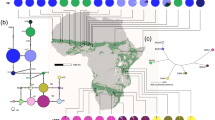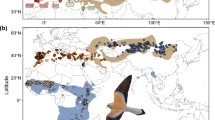Abstract
Many species are projected to become vulnerable to twenty-first-century climate changes1,2, with consequent effects on the tree of life. If losses were not randomly distributed across the tree of life, climate change could lead to a disproportionate loss of evolutionary history3,4,5. Here we estimate the consequences of climate change on the phylogenetic diversities of plant, bird and mammal assemblages across Europe. Using a consensus across ensembles of forecasts for 2020, 2050 and 2080 and high-resolution phylogenetic trees, we show that species vulnerability to climate change clusters weakly across phylogenies. Such phylogenetic signal in species vulnerabilities does not lead to higher loss of evolutionary history than expected with a model of random extinctions. This is because vulnerable species have neither fewer nor closer relatives than the remaining clades. Reductions in phylogenetic diversity will be greater in southern Europe, and gains are expected in regions of high latitude or altitude. However, losses will not be offset by gains and the tree of life faces a trend towards homogenization across the continent.
This is a preview of subscription content, access via your institution
Access options
Subscribe to this journal
Receive 51 print issues and online access
$199.00 per year
only $3.90 per issue
Buy this article
- Purchase on SpringerLink
- Instant access to full article PDF
Prices may be subject to local taxes which are calculated during checkout



Similar content being viewed by others
References
Thomas, C. D. et al. Extinction risk from climate change. Nature 427, 145–148 (2004)
Thuiller, W., Lavorel, S., Araújo, M. B., Sykes, M. T. & Prentice, I. C. Climate change threats to plant diversity in Europe. Proc. Natl Acad. Sci. USA 102, 8245–8250 (2005)
Mace, G. M., Gittleman, J. L. & Purvis, A. Preserving the tree of life. Science 300, 1707–1709 (2003)
Nee, S. & May, R. M. Extinction and the loss of evolutionary history. Science 288, 328–330 (1997)
Heard, S. B. & Mooers, A. O. Phylogenetically patterned speciation rates and extinction risks change the loss of evolutionary history during extinctions. Proc. R. Soc. Lond. B 267, 613–620 (2000)
Parmesan, C. Ecological and evolutionary responses to recent climate change. Annu. Rev. Ecol. Evol. Syst. 37, 637–669 (2006)
Meyers, L. A. & Bull, J. J. Fighting change with change: adaptive variation in an uncertain world. Trends Ecol. Evol. 17, 551–557 (2002)
Thuiller, W. Climate change and the ecologist. Nature 448, 550–552 (2007)
Purvis, A. Phylogenetic approaches to the study of extinction. Annu. Rev. Ecol. Evol. Syst. 39, 301–319 (2008)
Thuiller, W., Lavorel, S. & Araújo, M. B. Niche properties and geographical extent as predictors of species sensitivity to climate change. Glob. Ecol. Biogeogr. 14, 347–357 (2005)
Prinzing, A., Durka, W., Klotz, S. & Brandl, R. The niche of higher plants: evidence for phylogenetic conservatism. Proc. R. Soc. Lond. B 268, 2383–2389 (2001)
McKinney, M. L. Extinction vulnerability and selectivity: combining ecological and paleontological views. Annu. Rev. Ecol. Evol. Syst. 28, 495–516 (1997)
Lande, R. Statistics and partitioning of species diversity, and similarity among multiple communities. Oikos 76, 5–13 (1996)
Chown, S. L. & Gaston, K. J. Areas, cradles and museums: the latitudinal gradient in species richness. Trends Ecol. Evol. 15, 311–315 (2000)
Mitchell, T. D. & Jones, P. D. An improved method of constructing a database of monthly climate observations and associated high-resolution grids. Int. J. Climatol. 25, 693–712 (2005)
Baillie, J. E. M., Hilton-Taylor, C., Stuart, S. N., eds. 2004 IUCN Red List of Threatened Species. A Global Species Assessment (International Union for Conservation of Nature, 2004)
Bambach, R. K. Phanerozoic biodiversity mass extinctions. Annu. Rev. Earth Planet. Sci. 34, 127–155 (2006)
Koch, P. L. & Barnosky, A. D. Late Quaternary extinctions: state of the debate. Annu. Rev. Ecol. Evol. Syst. 37, 215–250 (2006)
Thuiller, W., Lafourcade, B., Engler, R. & Araujo, M. B. BIOMOD – a platform for ensemble forecasting of species distributions. Ecography 32, 369–373 (2009)
Nakicenovic, N. & Swart, R. Emissions Scenarios: A Special Report of Working Group III of the Intergovernmental Panel on Climate Change 570 (Cambridge Univ. Press, 2000)
Marmion, M., Parviainen, M., Luoto, M., Heikkinen, R. K. & Thuiller, W. Evaluation of consensus methods in predictive species distribution modelling. Divers. Distrib. 15, 59–69 (2009)
Smith, S. A., Beaulieu, J. M. & Donoghue, M. J. Mega-phylogeny approach for comparative biology: an alternative to supertree and supermatrix approaches. BMC Evol. Biol. 9, 37–48 (2009)
Fritz, S. A., Bininda-Emonds, O. R. P. & Purvis, A. Geographical variation in predictors of mammalian extinction risk: big is bad, but only in the tropics. Ecol. Lett. 12, 538–549 (2009)
Pavoine, S., Ollier, S., Pontier, D. & Chessel, D. Testing for phylogenetic signal in phenotypic traits: new matrices of phylogenetic proximities. Theor. Popul. Biol. 73, 79–91 (2008)
Blomberg, S. P., Garland, T. & Ives, A. R. Testing for phylogenetic signal in comparative data: behavioral traits are more labile. Evolution 57, 717–745 (2003)
Pagel, M. Inferring the historical patterns of biological evolution. Nature 401, 877–884 (1999)
Witting, L. & Loeschke, V. The optimization of biodiversity conservation. Biol. Conserv. 71, 205–207 (1995)
Acknowledgements
This research was funded by the EU ECOCHANGE (GOCE-CT-2007-036866) and DIVERSITALP (ANR-2007-BDIV-014) projects. C.R. was supported by a grant from Fundación Ramón Areces. We thank P. Pearman and A. Mooers for comments on earlier drafts. Computations were performed using the CIMENT infrastructure (https://ciment.ujf-grenoble.fr), supported by the Rhône-Alpes region (GRANT CPER07-13 CIRA).
Author information
Authors and Affiliations
Contributions
W.T. and S.L. designed the study, C.R. built the plant and bird phylogenies, I.B. and B.L. helped with R code writing, and W.T. performed all the analyses. W.T., S.L. and M.B.A. wrote the manuscript with substantial contributions from all authors.
Corresponding author
Ethics declarations
Competing interests
The authors declare no competing financial interests.
Supplementary information
Supplementary Information
The file contains Supplementary Figures 1-8 with legends, Supplementary References, Supplementary Table 1 and a Supplementary Methods section containing additional figures, tables and references. (PDF 1386 kb)
Rights and permissions
About this article
Cite this article
Thuiller, W., Lavergne, S., Roquet, C. et al. Consequences of climate change on the tree of life in Europe. Nature 470, 531–534 (2011). https://doi.org/10.1038/nature09705
Received:
Accepted:
Published:
Issue Date:
DOI: https://doi.org/10.1038/nature09705
This article is cited by
-
Global multifaceted biodiversity patterns, centers, and conservation needs in angiosperms
Science China Life Sciences (2024)
-
Preliminary species diversity and community phylogenetics of wood-inhabiting basidiomycetous fungi in the Dabie Mountains, Central China reveal unexpected richness
IMA Fungus (2023)
-
Potential alternatives for Norway spruce wood: a selection based on defect-free wood properties
Annals of Forest Science (2023)
-
Phylogenetic conservatism in threatened species responses to climate change differs between functional types in the Gongga Mountains of China
Journal of Mountain Science (2023)
-
How do urbanization and alien species affect the plant taxonomic, functional, and phylogenetic diversity in different types of urban green areas?
Environmental Science and Pollution Research (2023)



